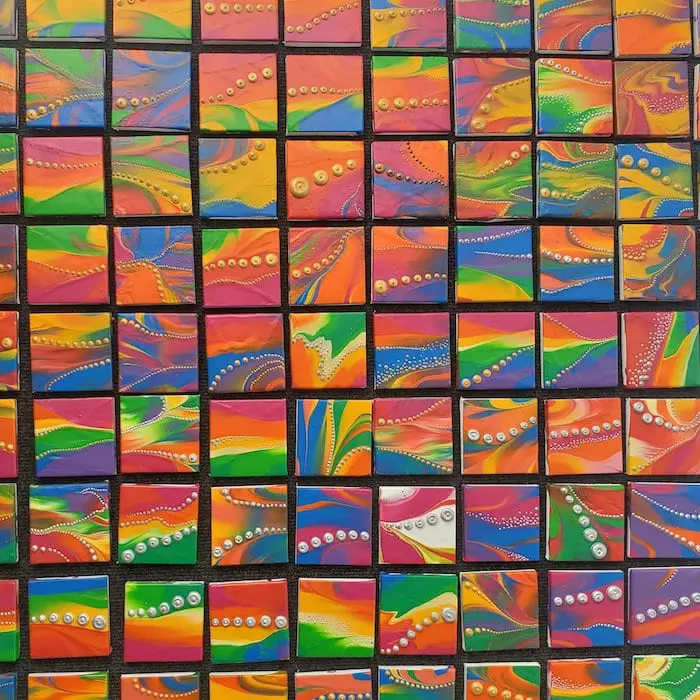Talking with other artists and creators is one of my favorite past times. I love learning about how other creatives work, what inspires them, and what their stories are. I never fail to walk away inspired, which is precisely what happened in my most recent interview with visual artist Sara O’Connor of Sara O’Connor Fine Arts.
We talked for about an hour and had an amazing conversation about her art, her podcast Bohemian Geek Studies, the intersection of art and consent, and the myth of the starving artist and why it needs to die. I couldn’t fit everything into one article, but our conversation was just so delicious, so delightful, that I’ve decided to provide you the entire thing to listen to!
Below you will find a truncated version of our interview and if you want to listen to the interview in full, just click here to head on over to Soundcloud.
Gretchen: So let’s start at the beginning, when did you start making art and what inspired you to become an artist?
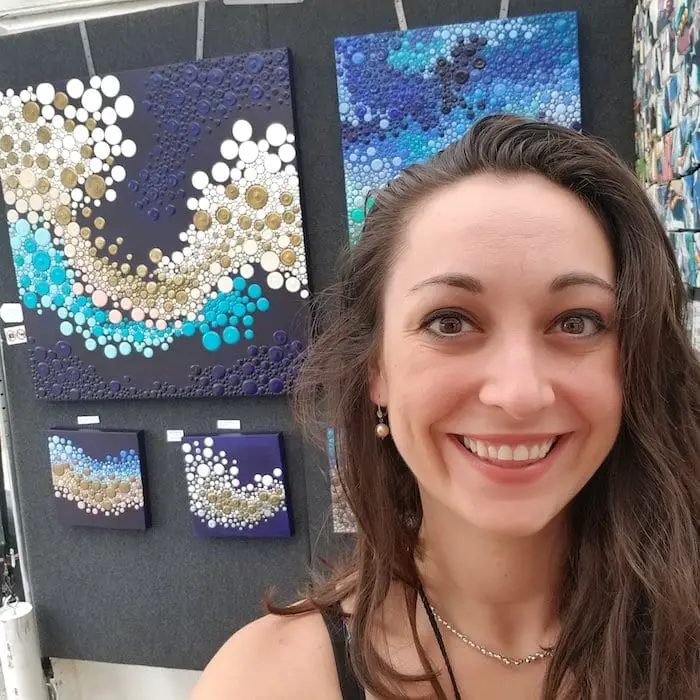 Sara O’Connor: So, like most people, it started really really young, thanks public education! Thanks pre-k! Thanks finger painting! I think at the core every single one of us is an artist, and some of us as we grow up remember that and some of us either forget it or transition their skillsets to different things.
Sara O’Connor: So, like most people, it started really really young, thanks public education! Thanks pre-k! Thanks finger painting! I think at the core every single one of us is an artist, and some of us as we grow up remember that and some of us either forget it or transition their skillsets to different things.
But from a non-colloquial standpoint, I started becoming a ‘professional’ artist December 2016 because that’s when I left the practice of law to pursue what had become a budding business to see how far I could really take this.
G: From law to art, that’s a pretty big shift!
SO: What’s interesting is a lot of people think that it’s a really big shift, but one of the things that I talk about when I’m exhibiting at art shows or in my own podcasting work is that it’s actually not, because at the end of the day, what is a lawyer doing? Trying to create a narrative, a story to help their audience achieve their goals and their vision. That’s exactly what an artist is doing but instead of, or in addition to, words there’s color, sound, etc. So in some ways they’re very different and in other ways it’s as easy as just changing your shirt.
G: You have such a unique style and subject matter choice: dots laid on in thick layers. How did that develop for you? Did you eat a lot of candy dots as a child?
SO: This question totally comes up all the time and it makes me so ecstatic that it does, because one of the things that I want to do with my art is make people want to engage with it with more than one sense. Not just wanting to see it, and that is a noble pursuit in and of itself, but I actually want people to want to eat my artwork. You can’t do it!—Unless and until I do a collaboration with a candy company or a bakery. But I literally want people to feel how I do about my artwork: it’s literally in, around, on me all the time and there’s this idea of like, just consume it however you want people!
So yes, I did eat candy dots, those classic blue, yellow, and pink ones on the strip of paper that you might eat on the boardwalk, that’s definitely something I did. Funnily enough, I’m not too much of a sugary candy kind of gal, but I love the whimsical ‘just a sweet treat’ nature of it, and I think that kind of sentiment is what I pull from. I also really love the idea of when people ask, “Is it a macaroon? Is it a macaron? Is it a Hershey kiss?”—this kind of whimsical childlike delight to strip away preconceived notions of what is a “traditional painting.” I literally want people to want to respond like, “These paintings of snozzberries taste like snozzberries!” I want to show people that Willy Wanka can exist in the real world, and that person can be me, and that person can be you. You just have to figure out what your own kind of candy shop is.
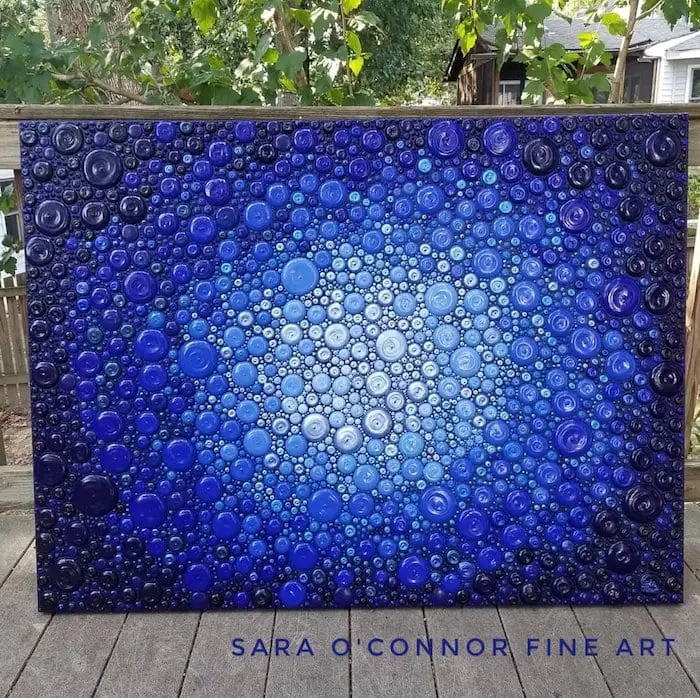
Let’s see what else is there? So, the evolution of the dots [began] back in September of 2015-ish, I needed to go on medical leave when I was an attorney and my husband had some hobby paint lying around, so I self-prescribed myself painting. During this time it was very traditional pointillism, which is the teensy-tiny microscopic dots that you might see on “mandala stones” that are very popular or just multilayered teensy tiny dots. And because of my love of ceramics back in high school, I really, really, really have wanted to (and finally been able to accomplish) the ability to get a rich texture and the brilliant coloring that I couldn’t accomplish with traditional clay and glazes. Certainly not in my particular kind of style or with the color security of knowing that’s how it’s going to turn out every single time.
Since I started truly trying to make this a professional career, I keep trying to elevate the dots and make them thicker and thicker. So if you went back onto my Instagram or had known me from 2015-2016, my dots have substantially increased in thickness since then. I think we’ll be talking about this later but when it comes to my floralism work, that’s a very, very recent thing.
G: Are you ever tempted to just…touch your paintings? I’m very tactile and find myself wanting to just run my fingers over your canvases and see what they feel like.
SO: As the creator, I really love the ability to touch my work, it’s a very intimate experience. With each of these dots I create, I’m not using molds or robotics, it’s just me, my brain, my hand, and a squeeze bottle just together going to town. I personally don’t often touch the dots once the work has been completed, because even when we clean our little cute mitts [aka, hands], we can sometimes leave oils on the paintings. After a long period of time, or especially after multiple people have touched it over multiple exhibitions, it can tarnish the colors. Or sometimes people in their excitement to experience my work have actually scratched it or damaged it a little bit, so what i like to say to people is, “You can touch her once she’s home with you.”
To the best of my ability, I’m working on helping people to start thinking about consent and safe touching and appropriate touching in a new and important arena. Like, “I am my own person. Do not touch me without permission!” My artwork is its own person, [it has] it’s own identity – do not touch it without its permission! And hopefully this is a way to start engaging all aspects and all demographics of the public regarding this very serious topic that has come up for me ever since I was a young girl.
G: That is really fascinating! Using your art as a medium of conversation to talk about consent in a larger framework, how did that come about for you?
SO: It’s really interesting. I think I’m still getting to know myself, getting to know my artwork, and getting to know what my short term and long term life goals are. In this technological age and in an age when we’re finally starting to talk about these very serious issues, art is a “safer” arena or at least an arena where people presumptively go into it with an open mind.
From my personal experiences and working as an attorney on cyber civil rights (colloquially referred to as ‘revenge porn’), the issue of consent is like a software program running in the background of my mind like: “this is societally important, so what are we going to do about it now that your professional role has changed?”
I suppose the more I’m getting to know myself and the more I’m getting to know what I want out of my artistic pursuit now that my career path has shifted, I’m slowly trying to figure out ways to package and voice that appropriately for my art business. It’s not something I have an easy, cut and dry “this is the forever answer” for. I think it’s something that’s going to be organic and morphing as I better learn myself, and as society itself changes. Hopefully, we can have more conversations like this and realize that these tough topics can occur across professions and across demographics.
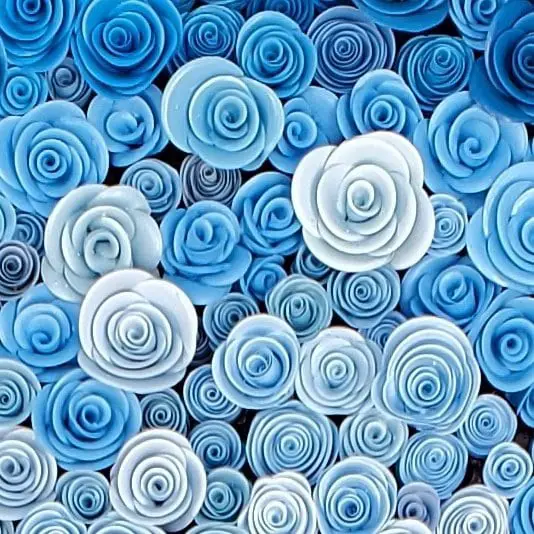
G: Let’s get back to your art itself, I want to talk about your floralism series—which is stunning by the way, love it—yet at the same time, not everyone who would look at it would realize that it’s a stylized dot.
SO: Again, it’s about education! Most people, and understandably so, think that my flowers are made out of paper, because that’s what they’ve seen before. Or some people who might have gone to more [art] shows might think that they’re porcelain flowers. I wanted to avoid the highs and the lows of ceramic firing woes, so I created my own formula to create flowers you might see from a porcelain artist but with that “Willy Wonka, something new, something you’ve never seen before, magic in the ordinary” vibe.
G: Do you have any other plans for creative evolutions of the dot that you want to talk about?
SO: Sure! I’ve fortunately been able to somehow roll out a new style or a newish series each year in a way, though [artists] don’t need annual arbitrary mile markers, that’s not the point. Rather, I want to ideally bring something new to my work in distinct series. So, one of the things that I just started experimenting with—there’s only one picture on Instagram about this—is the idea of having dots and/or flowers off canvas. Once so far I took a huge box of my dots when I traveled down to Florida, and I made a design from them on the sand by the water. So doing abstract ‘paintings’ in natural landscapes and photographing, that is something I’m really chomping at the bit for.
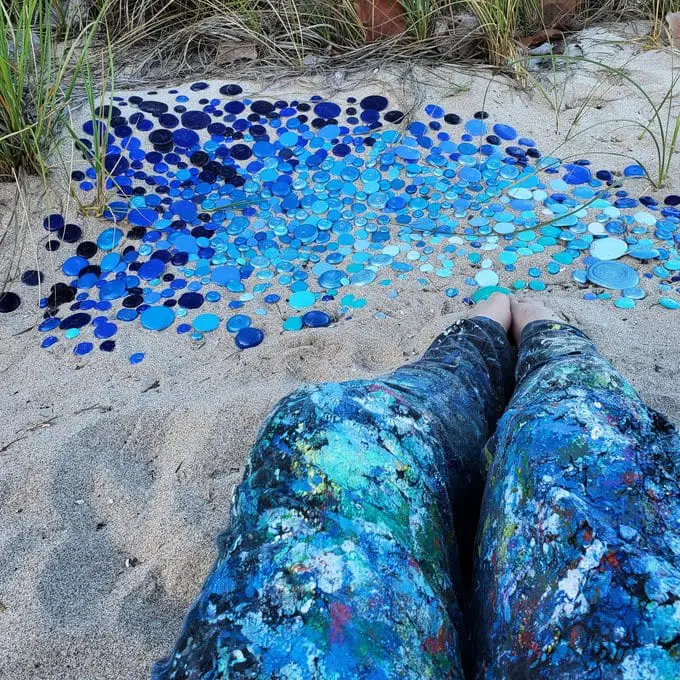
There’s an individual that’s in charge of a high school music program around here and I’m in initial talks with him to create something that weds music and my artwork, ideally with high school and/or college students who are playing music. If you’re familiar with the book The Phantom Tollbooth (it’s one of my favorite books) there’s the chapter in there where Milo, the protagonist, takes the orchestra conductors baton and plays the music of the dawn and dawn rises. But, because the protagonist has never done this before, crazy colors and crazy sounds happen, it’s a rigamarole. What I wanted to do and what I’ve wanted to do for about two decades now, is create that orchestra moment in real life.
In a non-traditional art aspect, but still creatively important, I’ve been working on a podcast called Bohemian Geek Studies. We’re currently working through Matilda because again, that little minx from Roald Dahl, she’s a feisty gal and some of that magic and whimsy really really inspires me.
G: That sounds exciting! Tell us more about your podcast.
SO: I had been wanting to do a podcast for quite a while. Let me give a shoutout to Robert of In Deep Geek by way of example. Robert and I met online probably about 2ish years ago by now and I was and am smitten with how this gentleman walks through things like Game of Thrones, Westworld, a little bit of Lord of the Rings, etc. Now that I’m not a practicing attorney and am no longer a professor in a brick and mortar institution (because I did that for a hot beat), I really still wanted to educate people in a particular way, and I knew generally that I wanted it in part to focus on children’s literature, but I knew that I couldn’t do it alone. Robert was really helpful in giving me some ideas early on. I also just happened to join the Facebook group for one of my favorite podcasts called “Binge Mode,” which is something I never do. And wouldn’t you know it, I met Will Li there and he was willing to go out on a limb with me and help me bring this vision for a podcast dissecting Matilda and other children’s literature to life.
From there, we’ve brought on guest hosts and we’re restructuring a little bit to hopefully make an in tandem podcast. On one channel we have it more adult-content-y and on another channel that’s going to be rolled out probably in September is going to be the “kid’s zone” We had originally tried to have it happen all in one place, but kids attention spans are arguably shorter than adult’s so for the goals we wanted to accomplish, it really needed to be broken up into two podcasts. That’s what we’re working on now.
So if you’re an adult and you want just the more adult content, jokes, tinfoil, really digging into the fandom aspects or the narrative devices and storytelling devices, you’d go to Bohemian Geek Studies. And if you wanted to see how these kids stories are from the teacher perspective, we’re hoping to have a second podcast with the help of one of our friends, Flo, who is a phenomenal teacher. We’re going to be working with her and hopefully repackaging these scripts to make it accessible to children and schoolrooms so that if parents and kids want to talk about books, we’re speaking to both of them in their language before they then come together as a family to talk about the book.
[Editor’s Note: Since this interview, additional incredible geeks have officially joined the cause, including Colleen McMillan, Florian “Flo” Siegel, and Matthew Pensinger. Matilda is now wrapped up, we are almost done covering Star Wars: Clone Wars, Season 7, and are looking to go full deep dives and adult content comedy in one place on Bohemian Geek Studies when we drop our next topic.]
G: Speaking of nerdy things like books, I met you through the ASOIAF fandom, do you see your fandom interests as having influenced your art in any way?
SO: Unequivocally! I largely want and need something visual, ideally with just gorgeous music, playing in my studio, which is technically my living room as well as little pockets of my house. So Game of Thrones, I have watched and not watched it an embarrassingly large amount of times? The long and short of it? Yes, yes yes!
Another one which is different from Game of Thrones and is much more young adult-y and much more romcom drama is the show Reign. That was on when I just started rolling out the very first of my heavy textured pointillism dots and both the costuming and the music swelling were very influential on some of my initial flowing color movement. For some of my pieces, not all of them, I’d be able to tell you exactly what I was watching when I was creating it. There’s one piece on my website called “Viking’s Voyage”, well guess what I was watching? The show Vikings.
One of these days maybe, if I stay cool and maybe become cooler, we’ll come back on and talk about all of the weird little easter eggs that I will remember having hid in my work. They’re there, I’m just a misidentified introvert and I don’t always share them. Which is a problem as an artist, because you need to share your stories! That’s what engages people and that’s why I’m really glad that I can talk about this with you.
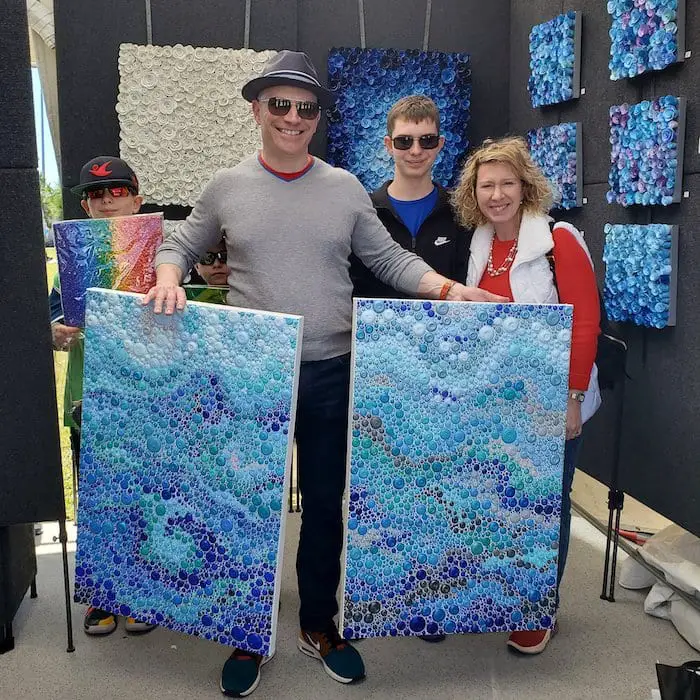
G: What is one piece of advice as an artist that you wish someone would have told you when you first became a professional artist?
SO: I think this is kind of a cheap answer, but it’s a genuine and candid one and one that I still have to tell myself and will probably still have to tell myself moving forward. That advice is: allow yourself to slow down.
Now, what do I mean by that? Speaking as someone who is naturally frantic sometimes, what I mean by that is as an artist (or frankly as a person) going throughout your life, you may feel quite frantic for all of the things that you wish you could accomplish or you think you can accomplish. When I began as an artist, I was and sometimes still am overwhelmed by the options I have at my disposal to reach out to different people or to offer different products. It can feel exhausting! There are all these different “must dos” that we as content creators ‘can’ and ‘should’ be doing, so I say slow down.
One of the things I’m working on in 2020 is really taking a step back and assessing what are my true genuine goals for a short amount of time and for a long amount of time and how am I lockstep going to get them [accomplished]. You could search online “what’s the best thing for Instagram or Facebook,” but look, fads are fads. If you want to be an artist, if you want to be a content creator, if you want to create something in the world, think about how you want to execute that plan and try and put on blinders to the rest of it because you can feel very overwhelmed by all of the things you “should” be doing. Slow down. And I say this as something I’m practicing myself and trying to get better at.
G: One final thing I wanted to hear your thoughts about is the idea of the starving artist. A lot of people these days seem to romanticize the idea of artists who are barely scraping by and struggling. You are a professional artist who is trying to make money off of your art, so how do you feel about the idea of the romanticized starving artist who’s barely making it?
SO: It’s so gross and so weird and unsustainable. It’s the weirdest thing. Cory Huff from The Abundant Artist wrote a short, nice article about the starving artist where he talks about how the idea of the bohemian lifestyle began with all these artists living together and barely scraping by. I think that becomes either a play or an opera, then that becomes the musical Rent, and then everyone thinks that because you’re an artist trying to make it and “living your dream” that’s what apparently the electrical company accepts for a bill payment. I don’t know about you, but I have yet to be able to pay for art supplies in exposure. And when I say ‘exposure’ that’s what people in the business will promise artists. Like, “If you just come to my shop and bring all of your friends and family to eat my warm and delicious panini, then I will hang your artwork, maybe you have to pay me a fee for that, maybe I get a portion of your sales, or maybe you’ve just marketed my business and I’ve paid you in ‘exposure.'” Well, exposure leaves you exposed, so, pay artists what they’re worth as long as the market will support that.
It’s a crazy universe that we find ourselves in where we elevate celebrities to the point of demigods and yet unless and until enough people have validated it, you’re supposed to just scrape by. That’s silly and wild. What we need to be doing is recognizing as early as pre-k and kindergarten that education is math, science, english, and it’s the arts. I’m a product of a diverse education and the most successful individuals in my humble opinion are the individuals that can think creatively. And if you don’t allow the arts to start early and encourage the arts early, then it becomes a self-fulfilling prospect of people bemoaning having to give up their passions and ridiculing and not supporting others who are trying to follow their artistic passions. There’s a lot of that language, and it is a fundamentally important aspect of my life to work toward reframing people’s thought process about pursuing art as a career.
G: Thank you so much for talking with me Sara, it’s been a pleasure!
SO: Thank you for having me!
—
Make sure to check out Sara’s art over on her website, Instagram, and Twitter. You can listen to her podcast on whatever platform you enjoy most by searching for “Bohemian Geek Studies.” And you can join the growing BGS community over on Twitter (@GeekStudies) and Instagram (@bohemiangeekstudies)!
—
Stay safe and Happy Pride Month Everyone!
